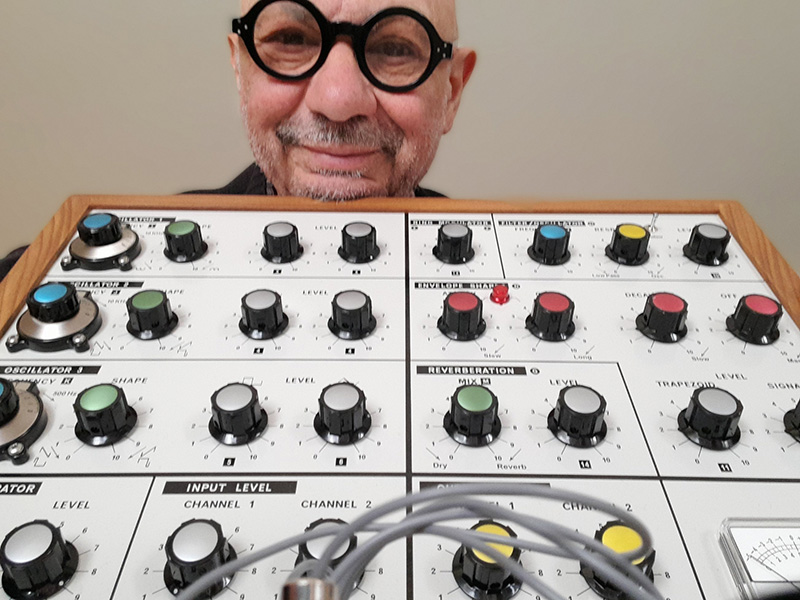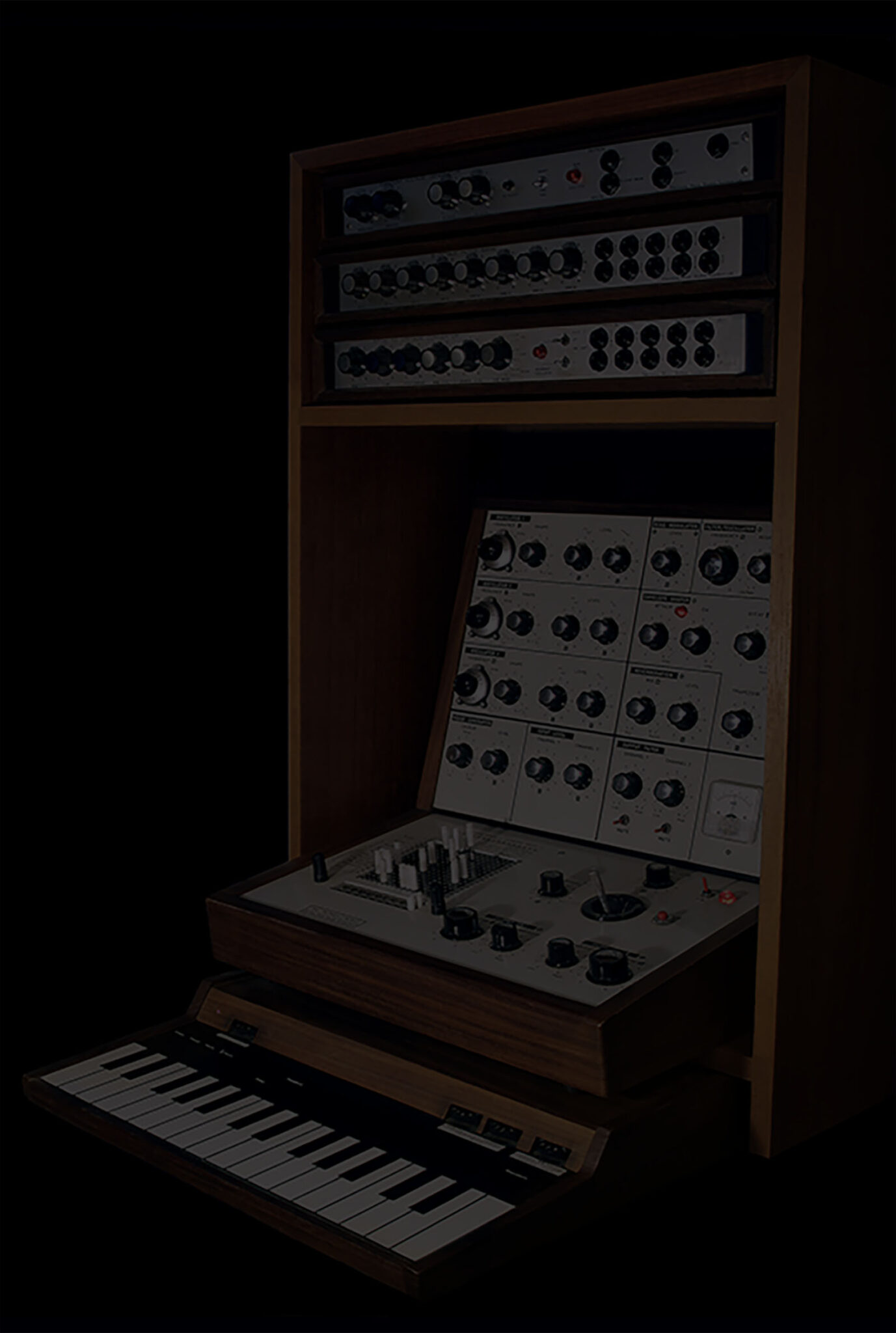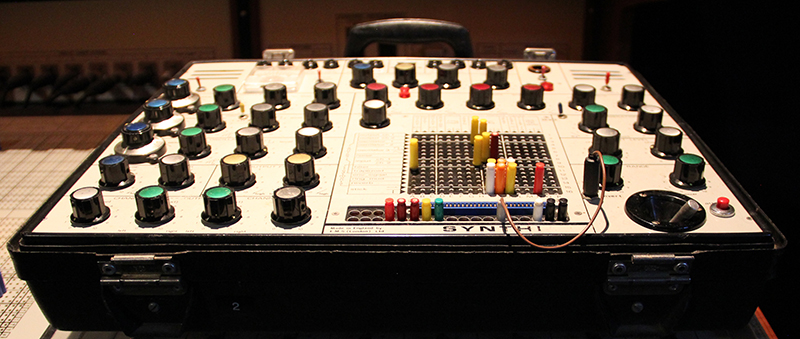
Synthisis Sonoris is bursting out as a companion to the seventh installment in our I.T.A.T.I.O.M. series dealing with Inventors Talking About Their Instruments Or Modules. Gathering composers playing synthesizers designed by the legendary EMS which changed the face of Electronic music back in the 70s… Mythical and typically associated with the British avant-garde highlights in the 70s from the BBC Radiophonic Workshop/White Noise/Delia Derbyshire to Pink Floyd, Hawkwind, Roxy Music/Brian Eno… But also to European composers like Pierre Henry, Bernard Parmegiani, Heldon, Tangerine Dream, Klaus Schulze, Kraftwerk, André Stordeur… In a few years the VCS3 + Synthi AKS made their marks within the experimental, electroacoustic groups all over the place and the Synthi proved to be one of the best resource for any live, easy to carry and so immediate. Legendary, unparalleled in sound, it gives a feeling of being alive and untamed. Trying it causes severe addiction !!!
In order to make your listening easier to digest I have chosen to divide « Synthisis Sonoris » into 3 sessions.
Here’s the first one:
01. Philippe Petit – A Call (11:19)
A journalist for various magazines and radio DJ since 1983, as well as a musical activist, I have celebrated 35+ years of sharing/transmitting my musical passions.
Since the early 2000s I have been introduced as a « musical travel agent » and been performing the world, playing festivals all over Europe, Russia, Poland, Canada, USA, Mexico, Australia & Asia…
Feeling lucky to release on several international labels such as Aagoo, Opa-Loka, Southern UK, Monotype, Alrealon Musique, Beta Lactam Ring, Sub Rosa, HomeNormal, Important, HelloSquare, Public Eyesore, Utech, Staubgold, etc…
Fortunate enough to work with what people call a dream-team of collaborators: Lydia Lunch, Murcof, The European Contemporary Orchestra (E.C.O.), Mark Cunningham (MARS), Cindytalk, Iancu Dumitrescu’s Hyperion Ensemble, Stephen O’Malley, Faust, Eugene Robinson (Oxbow), Edward Ka-Spel (Legendary Pink Dots), Simon Fisher Turner, Scott McCloud (Girls Against Boys), Cosey Fanni Tutti (Throbbing Gristle), Foetus, Graham Lewis (Wire), Barry Adamson, Andy Diagram, Scanner, Machinefabriek, Mira Calix, Kammerflimmer Kollektief, Justin K. Broadrick, James Johnston (Gallon Drunk/Bad Seeds/Faust), ASVA, Jarboe, Jad Fair, Martin Dupont and many more…
I wanted to start our collection with this piece because when I decided to pay hommage to EMS I put out a call to my acquaintances playing those wonderful synthesizers they had invented. An appeal to their creativity so that finally our efforts are gathered and show that no instrument was, and will be capable of as much grace in experimentation.
Besides, as much as I may love synthetic music, I – sometimes – need mine to incorporate some « concrete elements », some acoustics and thus chose to marry the Synthi A with my piano soundboard while processing my voice calling out…
In parallel I also had in mind, living in Marseille, down South, that sometimes by the sea I can hear a call coming from down under… Are those sirens or those voices in my head…?

02. Lawrence Casserley – Transformations I (12:07)
Tape made in Royal College of Music Electronic Music Studio, 1970.
A composer, conductor and performer, to real time electro-acoustic music ; Lawrence Casserley was also professor of electro-acoustic music at the Royal College of Music in London.
By early 1970 the studio had acquired some interesting new equipment, some specially built voltage-controlled oscillators (based on Robert Moog’s published designs), and another EMS product, the Dynamic Filter. This was a very flexible voltage-controlled filter, consisting, in fact, of two filters that could be linked either in series or parallel as well as being used in high pass or low pass mode. This enabled both band pass and band reject filters to be created, with separate voltage-control of bandwidth and band centre frequency. I was soon experimenting with networks of oscillators and filter to create a variety of sounds. I was particularly interested in the roughly voice-like sounds that could be produced, and one of these experimental patches produced the source material for “Transformations I”. The linking notion behind all of the Transformations series was that they present a source sound in direct juxtaposition with transformations of itself. In other pieces the source sound is the live instrument (piano or flute); here it is a continuous take from one of my oscillator/filter networks.
I devised a structure which alternates sections of the original sound with sections of transformation; in each case I used the removed section as material for the transformations, although in some later sections I also used previous transformation sections as material. Each transformation section occupies the same amount of time as the removed section of original sound. It is as though the source sound is travelling behind a window with alternating panes of clear glass and distorting glass. The main component of transformation is a sequence of progressive ring modulation, which is a development of the technique I used in The Final Desolation of Solitude (my first electronic tape piece). The transformations increase in intensity and complexity up to the climactic seventh, before sinking to a quiet conclusion, although once again the apparent innocence of the opening sounds is not achievable; another journey of transformation. As so often in my pieces, this structure, taken on its own, sounds very rigid and limiting, but actually it provides a framework within which I could set my imagination free. This piece has humour and drama that dance around each other in an unpredictable way; it allowed me to improvise with the material.
Two things were crucial to my experience at this time, and both of them can be traced back to Stockhausen’s “Kontakte” (which I had heard in Chicago in 1963 – a crucial epiphany). One is the sense of working directly with sounds as physical objects which can be manipulated, which I have compared with moulding clay (and Stockhausen’s realisation score for “Kontakte” was an inspiration here); the second is that this approach was freeing me from the pitch-based thinking of the music I had been composing before this. In the next two pieces in the ‘Transformations’ series pitch-based composition is certainly important, but it is primarily a means of achieving sound manipulation ends. The relationship between the sound of the ‘source’ and its transformation was becoming the crucial issue.
So what do I mean by “Transformation”? Each of these pieces has a very different sound world, but each is a stage on one journey. This is a journey to explore how sounds can be transformed, how journeys that start from one place can arrive at some very different and often surprising place. A piano generates a series of new electronic sound worlds (“Transformations II”); a flute produces pitches that are otherwise impossible (“Transformations III”); electronic sounds mutate into new forms; and it is the way these changes happen that is the real music. Whether I am transforming lead into gold, or pumpkins into carriages (or indeed carriages into lead, or gold into pumpkins) is less important; it is the way in which those transformations occur, the relationship between the original and the transformation; that is what this music is all about.
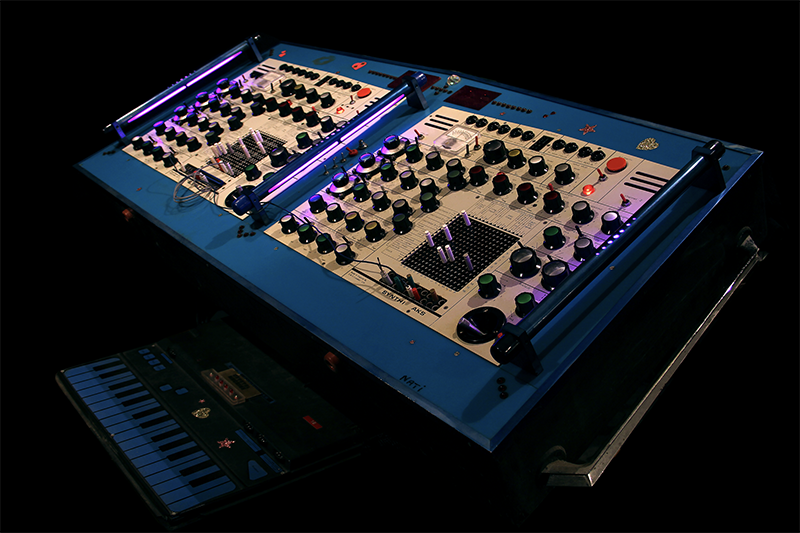
03. Benge : Study For 3 Synthi (08:02)
Ben Edwards is a composer, producer and collaborator, writing, recording, mixing and created his own studio: Memetune. I started working with him when he was doing Tennis (a duo with Douglas Benford from Sprawl Imprint) and released 2 albums on BiP_HOp. Later on I had pleasure following/supporting his Expanding label and his playing more and more beautiful Vintage synths…
I bought my VCS3 and DK1 way back in 1990, it was one of the first synths I ever bought, and the first ‘modular’ system that I got. It was very cheap back then, before they became collectable, and it is a very beautiful Mk1 model. I bought it directly from Robin Wood and made the long drive down to Cornwall from London and back to pick it up.
There is something very warm and fuzzy about the Mk1 units, quite a different sound to later ones, I think due to the amplifier components. Everything seems to meld together in a very organic way.
I recently acquired a set of EMS units as a gift (I rescued them from being chucked out actually) including a TKS sequencer, 8-Octave Filter Bank, Pitch to Voltage Converter and Random Signal Generator, so I have a nice suite of EMS gear.
Even more recently I have on loan from a friend a double Synthi, which I also used on this recording. The unit is the infamous ‘Crystal Machine’ owned originally by Tim Blake. This machine has a Mk1 and Mk2 Synthi in a custom case with a KS sequencer and all the most common modifications that are done to Synthis, such as oscillator sync, waveform modulation, buffered matrix, and inverter pins
All together they make up a very powerful system
04. Stelios Giannoulakis (Schema Musicalis) – Synthi 100 Grainscape (13:34)
Using recording equipment and the modern electronic music studio Stelios Giannoulakis integrates many different types of sound material into works articulating a personal musical language. Employing live performance and sound synthesis techniques, sonic transformations and elaborate editing he experiments with concepts, degrees of control, stylistic, aesthetic and compositional approaches, as well as with the ideas of tension, manipulation and resonance.
His electroacoustic works are being performed at international festivals and conferences ; he is teaching and writing about music and technology in Athens + a founding member of HELMCA (Greek Union of Composers of Electroacoustic Music).
I have been playing a VCS3 during my studies at the university of Bangor (Wales, UK) between 2000 and 2004. That VCS3 (The Putney) was actually found forgotten in storage, nobody knew how to make sound with it at the time. I did some minor repairs, gave it new life, and put it central place in the electroacoustic studio. No wonder, I fell in love with the EMS synth vibe and workflow, the sound and huge range of the oscillators, the filter, the envelope shaper, and everything else. Using the joystick I could transform between very different sounds in a single gesture, so I would regularly use it to facilitate transitions between sound objects with totally different sonic as well as symbolic characteristics, within electroacoustic music pieces and improvisation sessions.
I knew there was a Synthi100 in Athens, at the Contemporary Music Research Center, but for various reasons I never got around playing with it. Finally, just before the lockdown, I had the opportunity to work with it for a couple of weeks. I set up the synth for live drone-glitch-noise improvisation, and recorded many hours of material. Synthi100_Grainscape was made from these recordings
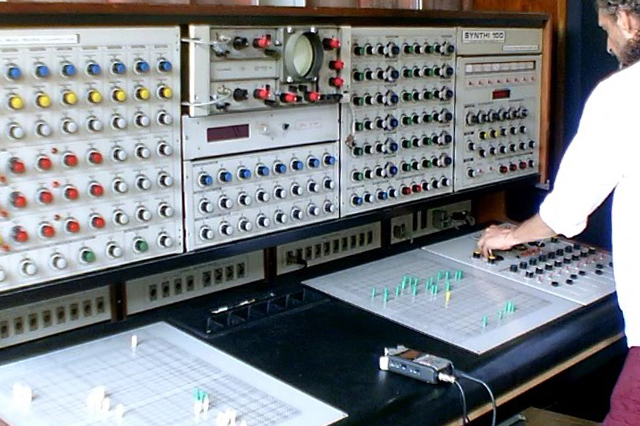
05. James Gardner : au-delà de deux rivières (05:36)
James Gardner is an English born New Zealand musician and composer who spent much of the 1980s in London playing and programming keyboards and synthesizers for a variety of artists. He moved to New Zealand in 1994. In 1996, he set up the contemporary ensemble 175 East, which he directed until 2010 and his compositions have been played and broadcast throughout the world.
For some years he has been researching the history of the synthesiser company EMS with a view to publishing an authoritative book on the subject.
Gardner is also a broadcaster on music on the New Zealand radio station Radio New Zealand Concert. He teaches music at the University of Canterbury in Christchurch, Unitec and the University of Auckland, and writes and presents shows covering contemporary music…
There was no particular aim at the beginning of working on this track but I allowed it to evolve “naturally”. A lot of my music tends to change quickly or jump from one sonic area to another, so I wanted to try to let the piece “sit” for a while without, I hope, becoming boring.
I chose to use only sounds that I patched on a single 1976 EMS Synthi A, on loan from the University of Canterbury, Christchurch. I decided that I would use only those kinds of audio processing that were available in 1975 (a rather arbitrary limit) although this processing was done with plug-in emulations, rather than the real thing. So I allowed myself “tape” delay, phasing, plate reverb, natural chamber reverb and spring reverb.
I limited myself to no more than eight tracks of material at any time, and bounced tracks down if I needed more, just as one would have to do on an eight-track tape machine.
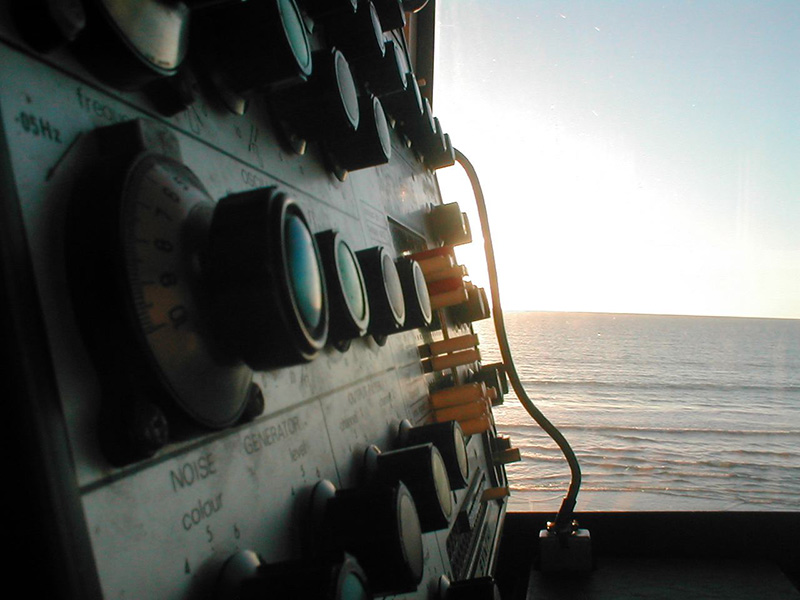
06. Ian Boddy – Enceladus (14:03)
Ian Boddy is a UK musician who first got into electronic music in the late 1970s. Since 1999 he has run the well respected Electronica label DiN releasing over 90 albums as well as more recently curating the Tone Science series. He has also composed many library music albums as well as being a much sought after sound designer.
Everything you hear is from my VCS3 with just the addition of Tape Echo, Moog Delay, Spring Reverb & Analogue Phaser. I sent various CVs into the VCS3 via the 2 Hi-Level Inputs. The sequencer I used for the middle section was the Analogue Systems RS200 + I used some RS&H & envelopes.
The first section features a strange filter feedback patch I use which almost sounds like a trumpet.
This then morphs into a huge Berlin School sequencing section although it has such a different feel as of course it’s not done on Moog Modular but the VCS3.
The final section features 2 keyboard parts that I improvised playing the DK2.
I’m actually pretty excited about this piece as I don’t really think anyone has quite done this before using just a single VCS3 as the sound source.
It definitely has a flavour and atmosphere all it’s own.
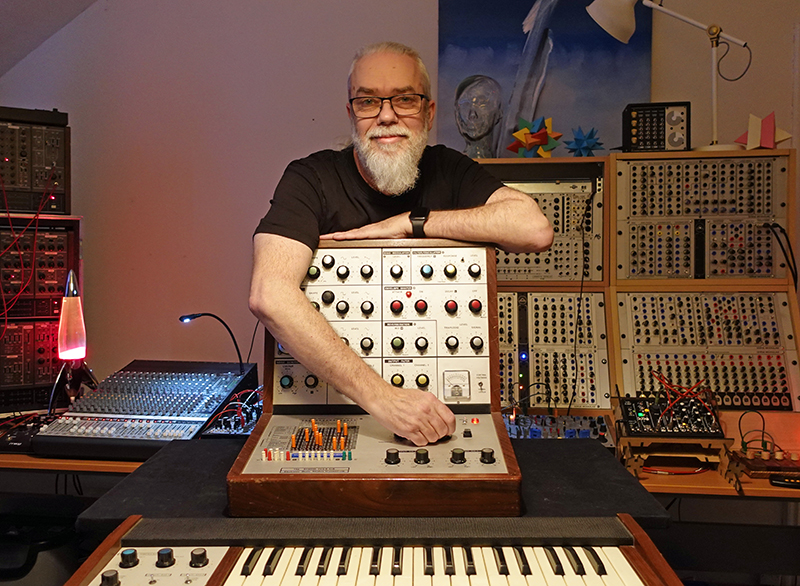
07. Yoshio Machida – synthitic37dub (13:44)
Yoshio Machida is a Japanese sound & visual artist + Steel Pan player.
He studied minimal art / music / film extensively under Kuniharu Akiyama, Yoshiaki Touno, Sakumi Hagiwara, Kishio Suga at Tama art university in Tokyo.
In 2004, Machida founded Amorfon a music label / a platform for contemporary art event. In 2021 he recorded a full session using the Synthi A which became our Modulisme 041.
I wanted to have a Synthi because I knew Brian Eno used it. In theory I knew almost everything a Synthi may achieve because I had simulated routing. But physical machine was more great comparing to imaginary machine in my brain. So many “unexpected” things (sometimes kind of error) are happened with this real machine. I feel this is really acoustic in its way.
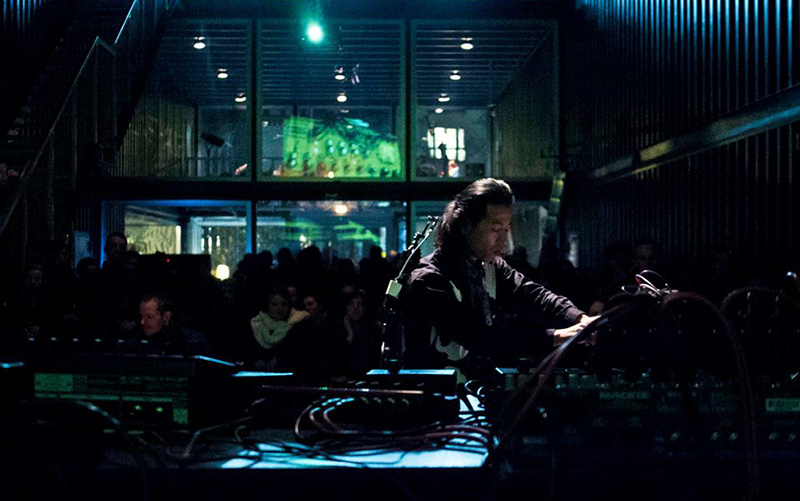
08. Constantin Papageorgiadis – Modulisme Improv (20:15)
Constantin Papageorgiadis is a tech specialized in EMS instruments who has serviced about 100 Synthis A, AKS and VCS3, adding on most many modifications that expand their possibilities, in a 100% reversible way, preserving the instrument’s original condition and aspect. He also repaired the IPEM’s Synthi 100 in Ghent and various other EMS equipment.
As a musician, he has released a solo LP as Trap&Zoid and a CD in duo with Yoshio Machida, using the Ghent Synthi 100.
My other big interest in synths is the Buchla 208/Music Easel, I offer DIY PCBs to build a 208 clone or expander cards that I created such as the 208 ToolBox and VCS3 Card. I build 208s and cards on order. My first synth was a Synthi AKS, I bought it to make sound effects in a Hawkwindish-style band where I played the bass. Exploring its sonic possibilities made me discover modular synthesis, I got other modular systems afterwards (eurorack, MU, Serge, Buchla) but my heavily modified Synthi AKS remains my main instrument. I prefer small self-contained portable systems whose “limitations” are inspiring, over a wall of modules.
Entering the Synthi and Buchla world completely changed my existence. I progressively got more and more involved thanks to my Synthi modifications and many other users got interested in my work… Working on synths finally became my main job and the best situation I ever had : earning a living from my passion. I meet a lot of great people, I travel, I am creative, I am my own boss, I can select jobs ad customers… My kid’s dream of making a living with music finally became real, not as a musician but as a tech, which I think is even more comfortable and pleasant.
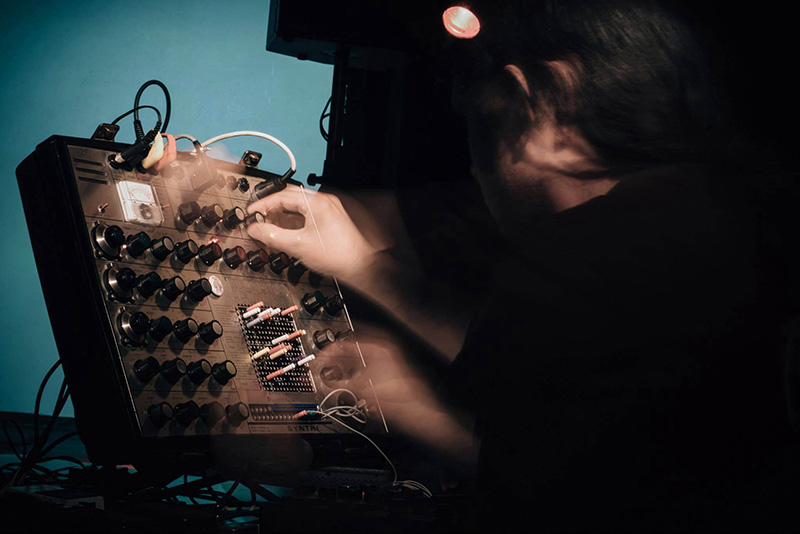
09. Robin Fox – Homeostasis for Duelling VCS3s (04:44)
Robin Fox is an internationally recognised audio-visual artist working across live performance, exhibitions, public art and composition for contemporary dance. His laser works, which synchronize sound & visual electricity in hyper-amplified 3D space have been performed in over 60 cities worldwide. In 2016 he became the founding director of MESS (Melbourne Electronic Sound Studio) a not for profit organisation dedicated to giving everyone access to the entire history of electronic musical instruments, hosting the EMS gear on which our track was recorded.
I was incredibly fortunate to inherit the electronic music studio of the late Australian composer Keith Humble which is now housed in the MESS collection for public use in Melbourne. It comprised, among other things, a Synthi A, VCS3mk2, random voltage generator, pitch to voltage converter and 8 octave filter bank. I basically learnt analog synthesis from the EMS manuals and, as a result, I still find the pin matrix the most intuitive method of patching synths! I love these machines. I love the way that each stage can be overdriven so beautifully. No other machine saturates quite as perfectly as the EMS.
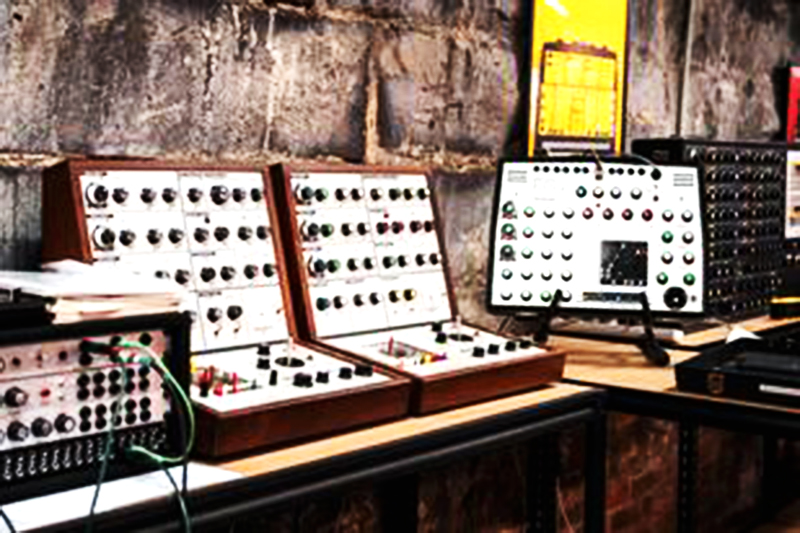
10. Bernard Filipetti – A&T belgian mix 1 (06:34)
An emblematic figure of the French alternative scene of the 70s and 80s, Bernard Filipetti has long heated the circuits of his analog synthesizers within the Camizole group or his solo project Art & Technique.
Raw, industrial, uncompromising.
The first time I saw a Synthi was when Dominique Grimaud bought one … 10,000 francs in 1974 (approx. 1500 euros). At the time, I was playing keyboard, organ while Dominique was making little noises…
The second time was at the Red Festival in Pantin at the slaughterhouses in October 1975; There was a French duo Atom Crystal playing with 2 synthis and between them a Tandberg tape recorder for the echo… They were playing sitting on the floor.
In 1979 I switched from keyboards to synthesizers. MS 20 MS 50 B.A.R PS 3300… tape echo… In 1981 I bought a second-hand Synthi which was unstable and half-broken… Towards the end of the 80’s, I started to really take an interest in synths, I had it brought into shape stability accuracy etc.
With the Indus wave of the 90s I started to integrate synths into my music. Today I have 2 totally modified CV / GATE
The way I use them today is a far cry from what we did with them in the 70s. The charm of this INSTRUMENT are the sometimes brutal reactions to a small change in volume. The sound of the synth is very thick “Unstable” fluctuating but soft violent charmer in short like love …
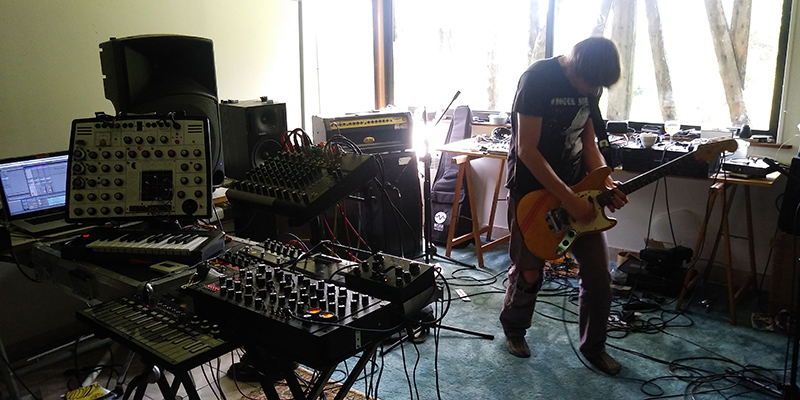
11. Dominique Grimaud & Véronique Vilhet – Dites le avec des Floors (02:13)
Véronique Vilhet and Dominique Grimaud are veterans of the French underground who appeared in the artistic and counter-cultural ferment that followed May 68. Their musical adventures and misadventures have taken them from the Avignon Festival to Caracas, from the Baalbek Festival to the Music Building in New York, via the charts of the New Musical Express.
Both of them followed the byways of self-production, but they also frequented some Chicago labels and even Barclay. Four decades later the duo performs mostly outside the official circuits, in self-managed venues, squats and the stores of the new generation of record shops.
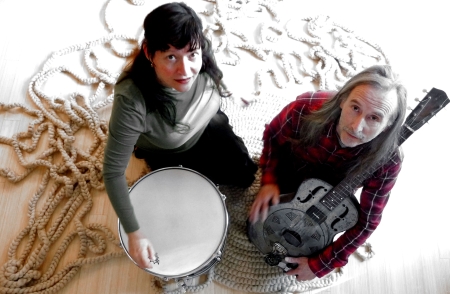
12. Vincent Epplay – Mentaliste Mémo (02:22)
Vincent Epplay is a French sound artist.
Since the beginning of the 90s, he has been developing an unclassifiable artistic work exploring the interaction between the sound process and visual forms. He began to develop a particular and forward-looking approach to electronic music, centred on intuitive composition, learnings from musique concrète and a poetic/humorous re-appropriation of vintage sound/film materials.
I first got exposed to the Synthi A through two major records of the 60s and 70s:
« White Noise, An Electric Storm » by David Vorhaus with the participation of Delia Derbyshire – which brought me to know the productions of The BBC Radiophonic Workshop.
« Video-Adventures Music for boys and girls » by Dominique Grimaud & Monique Alba – an impossible to classify record released on the famous English label Recommended Records.
Following these discographic discoveries, a friend with whom I started my first experimentations and sound scrambling lent me a VCS3… A first initiation with this evil and fantastic machine gave me the virus.
A few years later, my meeting with the composer Bernard Parmegiani who invited me one afternoon in his studio in Saint-Rémy-de-Provence, and gave me for a symbolic sum a whole set of “sound machines” as they called them, among which a Synthi AKS with its EMS sequencer keyboard – opened again to me “the doors of unheard sounds”!
This synthesizer remains my favorite machine, a most untamable instrument, with surprising possibilities and sounds.
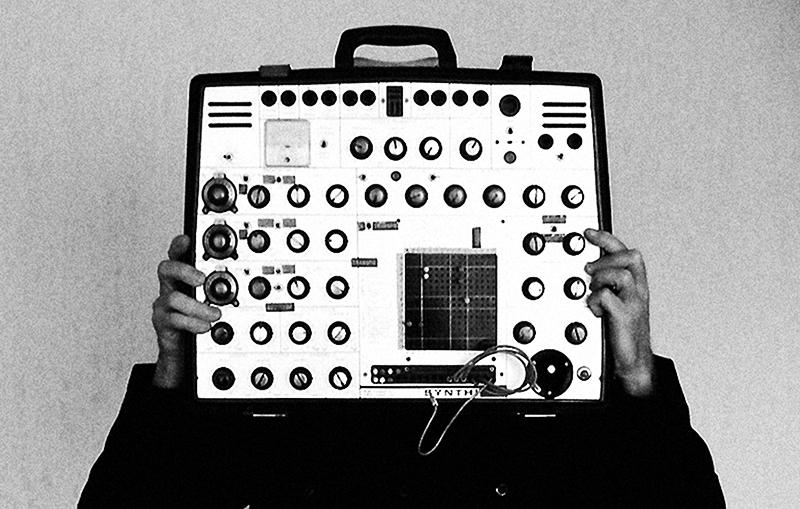
13. Headboggle – Bacon Groove (02:45)
San Francisco’s Derek Gedalecia has boasted over 100 releases in his twenty plus years composing and releasing music that spans from dense layered noise, synthesizer based works, avant neo-classical, to giddy electronics to ragtime piano… He is inviting to explore alien territories whether playing a Buchla Music Easel, a Synthi AKS and every instrument or production technique at his disposal.
After spending many years studying classical and ragtime piano, and then rock guitar in college bands, I was able to acquire an EMS Synthi A about 15 years ago.
This was the same year I acquired my first Eurorack (Doepfer) setup. The layout and sounds from the Synthi were so mind-expanding and enticing that my Doepfer system collected dust for a few years. I learned signal flow and modular synthesis first on the Synthi and then went on to refine that knowledge with other modular systems.
I have released many recordings and they almost always feature the Synthi A somewhere. Cheers to EMS for their designs and especially the Synthi which has and will bring me years of discovery and enjoyment
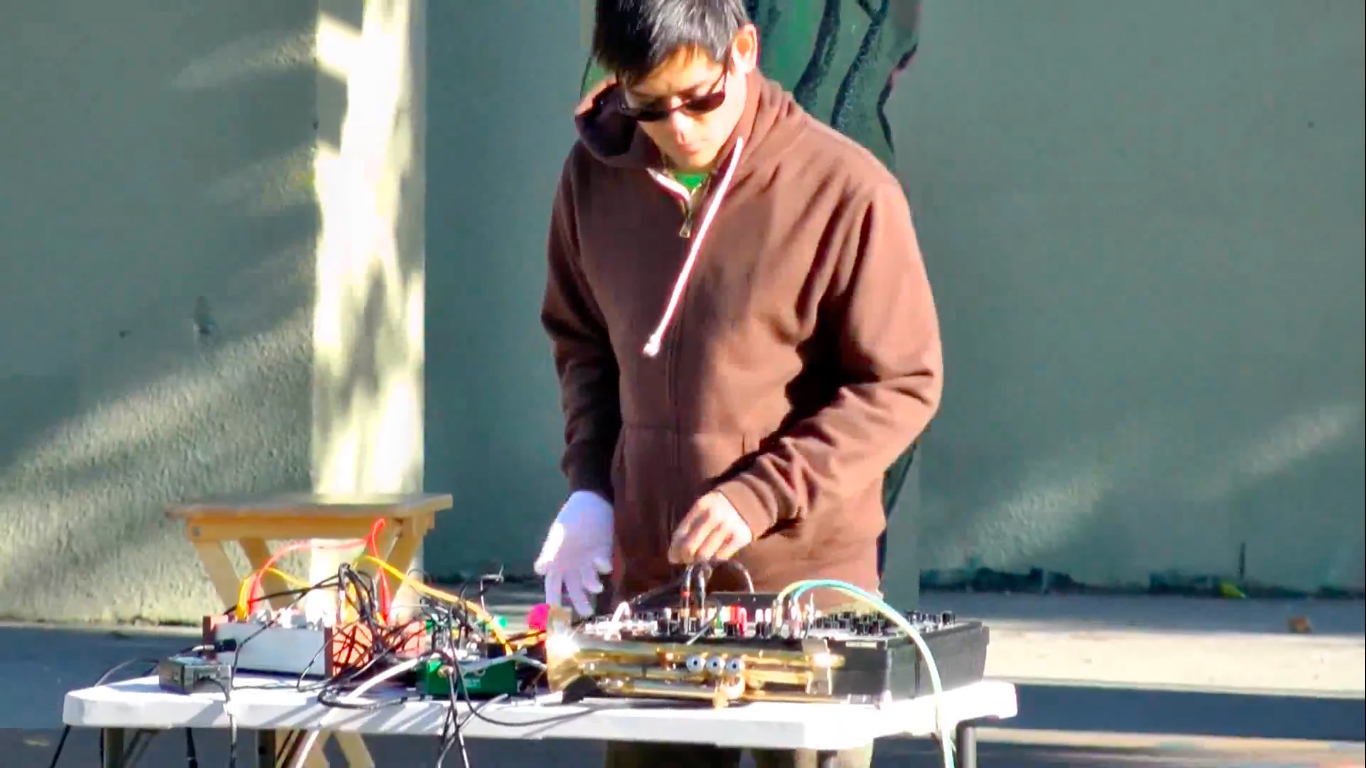
14. Mathew Watson – 09082014 (01:02)
Mat Watson is a Naarm (Melbourne) based artist focussed on the exploration of electronic sound and the drum set in many forms and under many guises. He has an extensive and diverse list of past and ongoing artist collaborations, and has performed at arts festivals, music festivals, galleries and theatres across Australia, Japan and the USA.
He has released solo and collaborative albums exploring a vast spectrum of sound, style and form, moonlighted with Bronx legends E.S.G, and collaborated on several large scale Boredoms BoaDrum performances in Australia and Japan. He wrote, arranged and conducted Magnitudes – a work for 40 synthesisers performed by the MESS Synthesiser Orchestra at the Sidney Myer Music Bowl in Melbourne and most recently, curated and produced HEAVY SPECTRA, an individual audio visual work, and event for experimental artists working with sonic densities at Max Watts in Melbourne, Australia.
My first contact with EMS was via Australian music legend Ollie Olsen. I met Ollie through a mutual friend back in January of 2006 and we quickly became great friends and started to make music together. Ollie’s sensibility and approach to electronic sound had a profound impact on my own approach to electronic sound.
Working with Ollie at that time signalled a huge shift in focus as I moved away from primarily playing in bands, to immersing myself in a highly personal sound world, with a focus on exploring process and art. I often think of this personal sound world as a response to a waking life, or coming from some type of dream state. Those are the sounds and ideas that continue to inspire and excite me and the Synthi is the machine that allows me to explore those curiosities and reflections.
I find the Aks can go from brutal to fragile in a breath and I love exploring all of it. The big revelation was learning to let go, accept and listen, not to bend it to my will. Embracing the Synthi’s nuanced behaviour allowed for those beautiful synchronous moments of an inner world manifesting through the instrument. Discovering empathy for the machine was a liberating moment. Each session I spend with the Aks yields new ideas, which lead to new sonic experiences and ultimately inspires a sense that time is standing still.
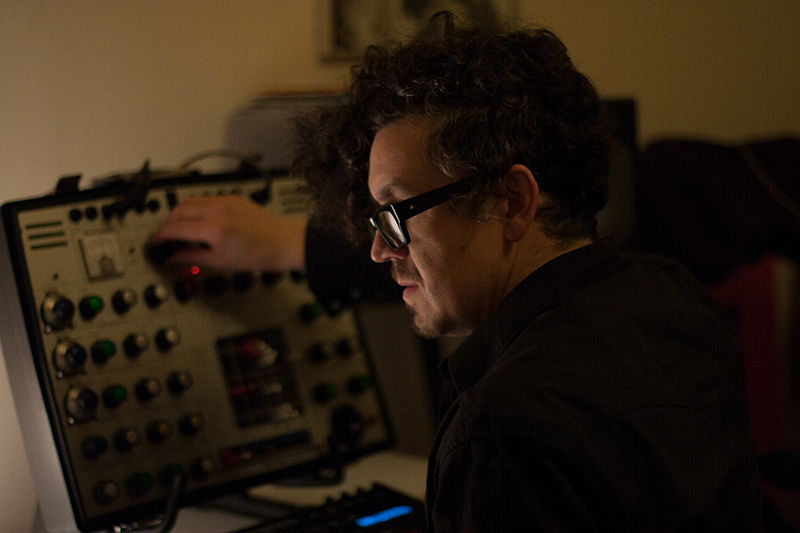
15. Willy Van Buggenhout – Modular (20:19)
Willy Van Buggenhout (16/04/1954) studied electronic music in Brussels with André Stordeur (studio synthèse) and Peter Beyls (Luca). He’s been playing EMS Synthi AKS for nearly half a century and been a member of several group-improvisations, working with many fine musicians and orchestras from all over the World !
When Philippe asked me for his ITATIOM on EMS, my Robin Wood custome designed EMS VCS3 Mk1 had just arrived! And due to Coronavirus confinement measures I could not have access to my Brussels studio equipment or improvise with other musicians as I usually like to do. So – I made this piece especially for Philippe’s ITATIOM on EMS exclusively playing this brand new VCS3 Mk1 . (As extra’s the VCS3 has VC osc shape, VC filter response and unslew, and an envelope follower).
Since my Teacher André Stordeur died last year – of corona- not so long after we honored him by giving the André Stordeur Tribute at the Antennafestival (Evergem-Ghent). I would like to dedicate “Modular” to his memory.
